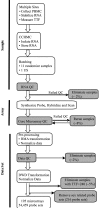Subtype-specific peripheral blood gene expression profiles in recent-onset juvenile idiopathic arthritis
- PMID: 19565513
- PMCID: PMC2782469
- DOI: 10.1002/art.24601
Subtype-specific peripheral blood gene expression profiles in recent-onset juvenile idiopathic arthritis
Abstract
Objective: To identify differences in peripheral blood gene expression between patients with different subclasses of juvenile idiopathic arthritis (JIA) and healthy controls in a multicenter study of patients with recent-onset JIA prior to treatment with disease-modifying antirheumatic drugs (DMARDs) or biologic agents.
Methods: Peripheral blood mononuclear cells (PBMCs) from 59 healthy children and 136 patients with JIA (28 with enthesitis-related arthritis [ERA], 42 with persistent oligoarthritis, 45 with rheumatoid factor [RF]-negative polyarthritis, and 21 with systemic disease) were isolated from whole blood. Poly(A) RNA was labeled using a commercial RNA amplification and labeling system (NuGEN Ovation), and gene expression profiles were obtained using commercial expression microarrays (Affymetrix HG-U133 Plus 2.0).
Results: A total of 9,501 differentially expressed probe sets were identified among the JIA subtypes and controls (by analysis of variance; false discovery rate 5%). Specifically, 193, 1,036, 873, and 7,595 probe sets were different in PBMCs from the controls compared with those from the ERA, persistent oligoarthritis, RF-negative polyarthritis, and systemic JIA patients, respectively. In patients with persistent oligoarthritis, RF-negative polyarthritis, and systemic JIA subtypes, up-regulation of genes associated with interleukin-10 (IL-10) signaling was prominent. A hemoglobin cluster was identified that was underexpressed in ERA patients but overexpressed in systemic JIA patients. The influence of JAK/STAT, ERK/MAPK, IL-2, and B cell receptor signaling pathways was evident in patients with persistent oligoarthritis. In systemic JIA, up-regulation of innate immune pathways, including IL-6, Toll-like receptor/IL-1 receptor, and peroxisome proliferator-activated receptor signaling, were noted, along with down-regulation of gene networks related to natural killer cells and T cells. Complement and coagulation pathways were up-regulated in systemic JIA, with a subset of these genes being differentially expressed in other subtypes as well.
Conclusion: Expression analysis identified differentially expressed genes in PBMCs obtained early in the disease from patients with different subtypes of JIA and in healthy controls, providing evidence of immunobiologic differences between these forms of childhood arthritis.
Figures



Similar articles
-
Biologic similarities based on age at onset in oligoarticular and polyarticular subtypes of juvenile idiopathic arthritis.Arthritis Rheum. 2010 Nov;62(11):3249-58. doi: 10.1002/art.27657. Arthritis Rheum. 2010. PMID: 20662067 Free PMC article.
-
Gene expression signatures in polyarticular juvenile idiopathic arthritis demonstrate disease heterogeneity and offer a molecular classification of disease subsets.Arthritis Rheum. 2009 Jul;60(7):2113-23. doi: 10.1002/art.24534. Arthritis Rheum. 2009. PMID: 19565504 Free PMC article.
-
Specific gene expression profiles in systemic juvenile idiopathic arthritis.Arthritis Rheum. 2007 Jun;56(6):1954-65. doi: 10.1002/art.22644. Arthritis Rheum. 2007. PMID: 17530721
-
Disease of the year: juvenile idiopathic arthritis-associated uveitis--classification and diagnostic approach.Ocul Immunol Inflamm. 2014 Feb;22(1):56-63. doi: 10.3109/09273948.2013.871565. Epub 2014 Jan 10. Ocul Immunol Inflamm. 2014. PMID: 24410427 Review.
-
2021 American College of Rheumatology Guideline for the Treatment of Juvenile Idiopathic Arthritis: Therapeutic Approaches for Oligoarthritis, Temporomandibular Joint Arthritis, and Systemic Juvenile Idiopathic Arthritis.Arthritis Care Res (Hoboken). 2022 Apr;74(4):521-537. doi: 10.1002/acr.24853. Epub 2022 Mar 1. Arthritis Care Res (Hoboken). 2022. PMID: 35233986 Free PMC article.
Cited by
-
Transcription factor motif enrichment in whole transcriptome analysis identifies STAT4 and BCL6 as the most prominent binding motif in systemic juvenile idiopathic arthritis.Arthritis Res Ther. 2018 May 30;20(1):98. doi: 10.1186/s13075-018-1603-2. Arthritis Res Ther. 2018. PMID: 29848367 Free PMC article.
-
Primary complement and antibody deficiencies in autoimmune rheumatologic diseases with juvenile onset: a prospective study at two centers.Pediatr Rheumatol Online J. 2015 Nov 21;13:51. doi: 10.1186/s12969-015-0050-8. Pediatr Rheumatol Online J. 2015. PMID: 26590091 Free PMC article.
-
Biologic similarities based on age at onset in oligoarticular and polyarticular subtypes of juvenile idiopathic arthritis.Arthritis Rheum. 2010 Nov;62(11):3249-58. doi: 10.1002/art.27657. Arthritis Rheum. 2010. PMID: 20662067 Free PMC article.
-
Correlation analyses of clinical and molecular findings identify candidate biological pathways in systemic juvenile idiopathic arthritis.BMC Med. 2012 Oct 23;10:125. doi: 10.1186/1741-7015-10-125. BMC Med. 2012. PMID: 23092393 Free PMC article.
-
Enhancing translational research in paediatric rheumatology through standardization.Nat Rev Rheumatol. 2016 Nov;12(11):684-690. doi: 10.1038/nrrheum.2016.156. Epub 2016 Sep 22. Nat Rev Rheumatol. 2016. PMID: 27652504 Review.
References
-
- Petty RE, Southwood TR, Manners P, Baum J, Glass DN, Goldenberg J, et al. International League of Associations for Rheumatology classification of juvenile idiopathic arthritis: second revision, Edmonton, 2001. J Rheumatol. 2004;31(2):390–2. - PubMed
-
- Donn RP, Ollier WE. Juvenile chronic arthritis--a time for change? Eur J Immunogenet. 1996;23(3):245–60. - PubMed
-
- Thompson SD, Moroldo MB, Guyer L, Ryan M, Tombragel EM, Shear ES, et al. A genome-wide scan for juvenile rheumatoid arthritis in affected sibpair families provides evidence of linkage. Arthritis Rheum. 2004;50(9):2920–30. - PubMed
Publication types
MeSH terms
Substances
Grants and funding
LinkOut - more resources
Full Text Sources
Medical
Molecular Biology Databases
Miscellaneous

